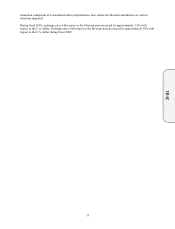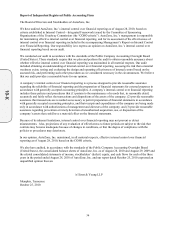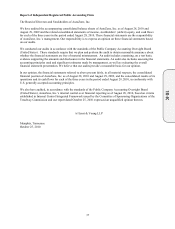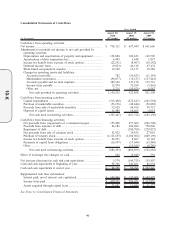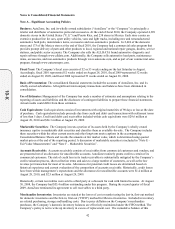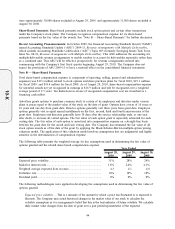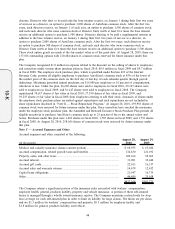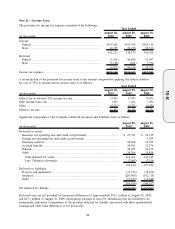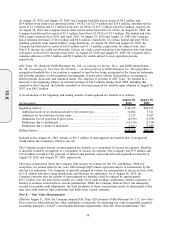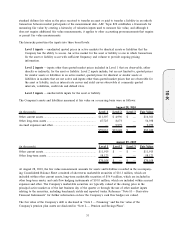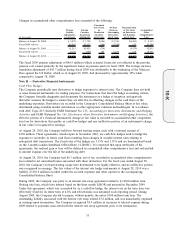AutoZone 2010 Annual Report Download - page 133
Download and view the complete annual report
Please find page 133 of the 2010 AutoZone annual report below. You can navigate through the pages in the report by either clicking on the pages listed below, or by using the keyword search tool below to find specific information within the annual report.
unrecorded adjustment, which will be reduced upon experiencing price inflation on our merchandise purchases,
was $247.3 million at August 28, 2010, and $223.0 million at August 29, 2009.
Property and Equipment: Property and equipment is stated at cost. Depreciation and amortization are computed
principally using the straight-line method over the following estimated useful lives: buildings, 40 to 50 years;
building improvements, 5 to 15 years; equipment, 3 to 10 years; and leasehold improvements, over the shorter of
the asset’s estimated useful life or the remaining lease term, which includes any reasonably assured renewal
periods. Depreciation and amortization include amortization of assets under capital lease.
Impairment of Long-Lived Assets: The Company evaluates the recoverability of its long-lived assets whenever
events or changes in circumstances indicate that the carrying value of an asset may not be recoverable. When such
an event occurs, the Company compares the sum of the undiscounted expected future cash flows of the asset
(asset group) with the carrying amounts of the asset. If the undiscounted expected future cash flows are less than
the carrying value of the assets, the Company measures the amount of impairment loss as the amount by which the
carrying amount of the assets exceeds the fair value of the assets. No impairment losses were recorded in the three
years ended August 28, 2010.
Goodwill: The cost in excess of fair value of identifiable net assets of businesses acquired is recorded as
goodwill. Goodwill has not been amortized since fiscal 2001, but an analysis is performed at least annually to
compare the fair value of the reporting unit to the carrying amount to determine if any impairment exists. The
Company performs its annual impairment assessment in the fourth quarter of each fiscal year, unless
circumstances dictate more frequent assessments. No impairment losses were recorded in the three years ended
August 28, 2010. Goodwill was $302.6 million as of August 28, 2010, and August 29, 2009.
Derivative Instruments and Hedging Activities: AutoZone is exposed to market risk from, among other things,
changes in interest rates, foreign exchange rates and fuel prices. From time to time, the Company uses various
financial instruments to reduce such risks. To date, based upon the Company’s current level of foreign operations,
no derivative instruments have been utilized to reduce foreign exchange rate risk. All of the Company’s hedging
activities are governed by guidelines that are authorized by AutoZone’s Board of Directors. Further, the Company
does not buy or sell financial instruments for trading purposes.
AutoZone’s financial market risk results primarily from changes in interest rates. At times, AutoZone reduces its
exposure to changes in interest rates by entering into various interest rate hedge instruments such as interest rate
swap contracts, treasury lock agreements and forward-starting interest rate swaps. All of the Company’s interest
rate hedge instruments are designated as cash flow hedges. Refer to “Note H – Derivative Financial Instruments”
for additional disclosures regarding the Company’s derivative instruments and hedging activities. Cash flows
related to these instruments designated as qualifying hedges are reflected in the accompanying consolidated
statements of cash flows in the same categories as the cash flows from the items being hedged. Accordingly, cash
flows relating to the settlement of interest rate derivatives hedging the forecasted issuance of debt have been
reflected upon settlement as a component of financing cash flows. The resulting gain or loss from such settlement
is deferred to other comprehensive loss and reclassified to interest expense over the term of the underlying debt.
This reclassification of the deferred gains and losses impacts the interest expense recognized on the underlying
debt that was hedged and is therefore reflected as a component of operating cash flows in periods subsequent to
settlement. The periodic settlement of interest rate derivatives hedging outstanding variable rate debt is recorded
as an adjustment to interest expense and is therefore reflected as a component of operating cash flows.
Foreign Currency: The Company accounts for its Mexican operations using the Mexican peso as the functional
currency and converts its financial statements from Mexican pesos to U.S. dollars. The cumulative loss on
currency translation is recorded as a component of accumulated other comprehensive loss and approximated $44.7
million at August 28, 2010, and $45.5 million at August 29, 2009.
Self-Insurance Reserves: The Company retains a significant portion of the risks associated with workers’
compensation, employee health, general, products liability, property and vehicle insurance. Through various
methods, which include analyses of historical trends and utilization of actuaries, the Company estimates the costs
of these risks. The costs are accrued based upon the aggregate of the liability for reported claims and an estimated
liability for claims incurred but not reported. Estimates are based on calculations that consider historical lag and
claim development factors. The long-term portions of these liabilities are recorded at our estimate of their net
present value.
43
10-K


